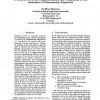Free Online Productivity Tools
i2Speak
i2Symbol
i2OCR
iTex2Img
iWeb2Print
iWeb2Shot
i2Type
iPdf2Split
iPdf2Merge
i2Bopomofo
i2Arabic
i2Style
i2Image
i2PDF
iLatex2Rtf
Sci2ools
EACL
1993
ACL Anthology
1993
ACL Anthology
A Tradeoff between Compositionality and Complexity in the Semantics of Dimensional Adjectives
Linguistic access to uncertain quantitative knowledge about physical properties is provided by dimensional adjectives, e.g. long-short in the spatial and temporal senses, near-far, fast-slow, etc. Semantic analyses of the dimensional adjectives differ on whether the meaning of the differential comparative (6 cm shorter than) and the equative with factor term (three times as long as) is a compositional function of the meanings the difference and factor terms (6 cm and three times) and the meanings of the simple comparative and equative, respectively. The compositional treatment comes at the price of a meaning representation that some authors ([Pinkal, 1990], [Klein, 1991]) find objectionally unparsimonious. In this paper, I compare semantic approaches by investigating the complexity of reasoning that they entail; specifically, I show the complexity of constraint propagation over real-valued intervals using the Waltz algorithm in a system where the meaning representations of sentences a...
Dimensional Adjectives | EACL 1993 | Factor Terms | Meaning Representations | Natural Language Processing |
| Added | 02 Nov 2010 |
| Updated | 02 Nov 2010 |
| Type | Conference |
| Year | 1993 |
| Where | EACL |
| Authors | Geoffrey Simmons |
Comments (0)

